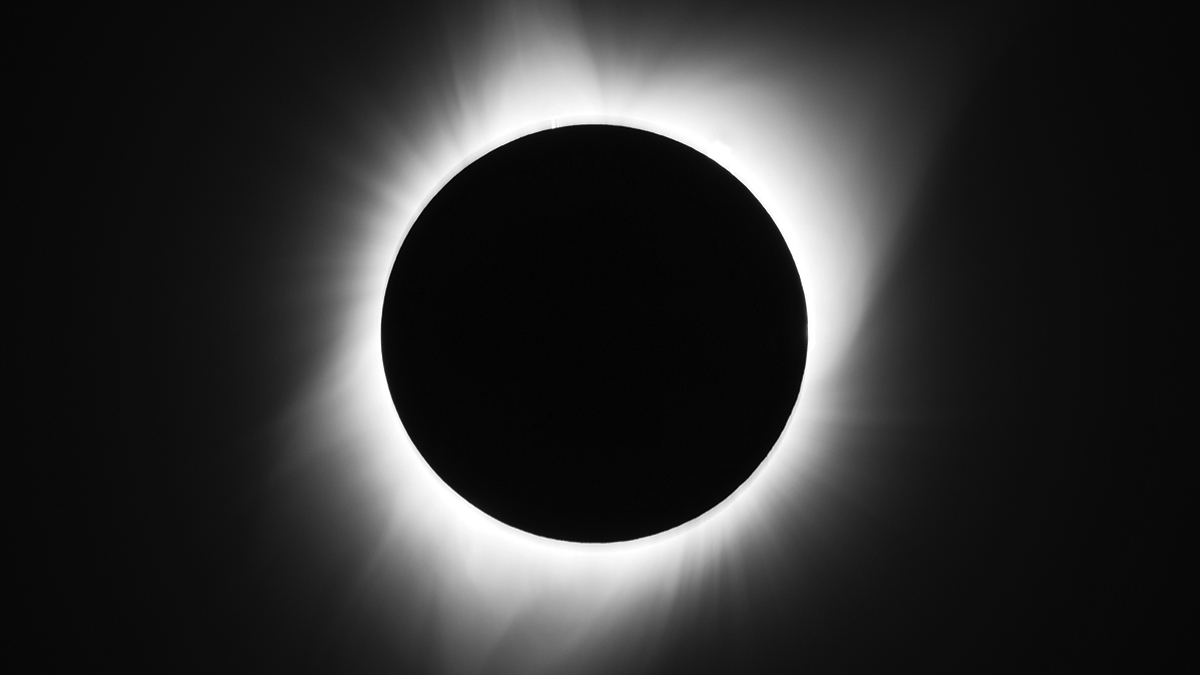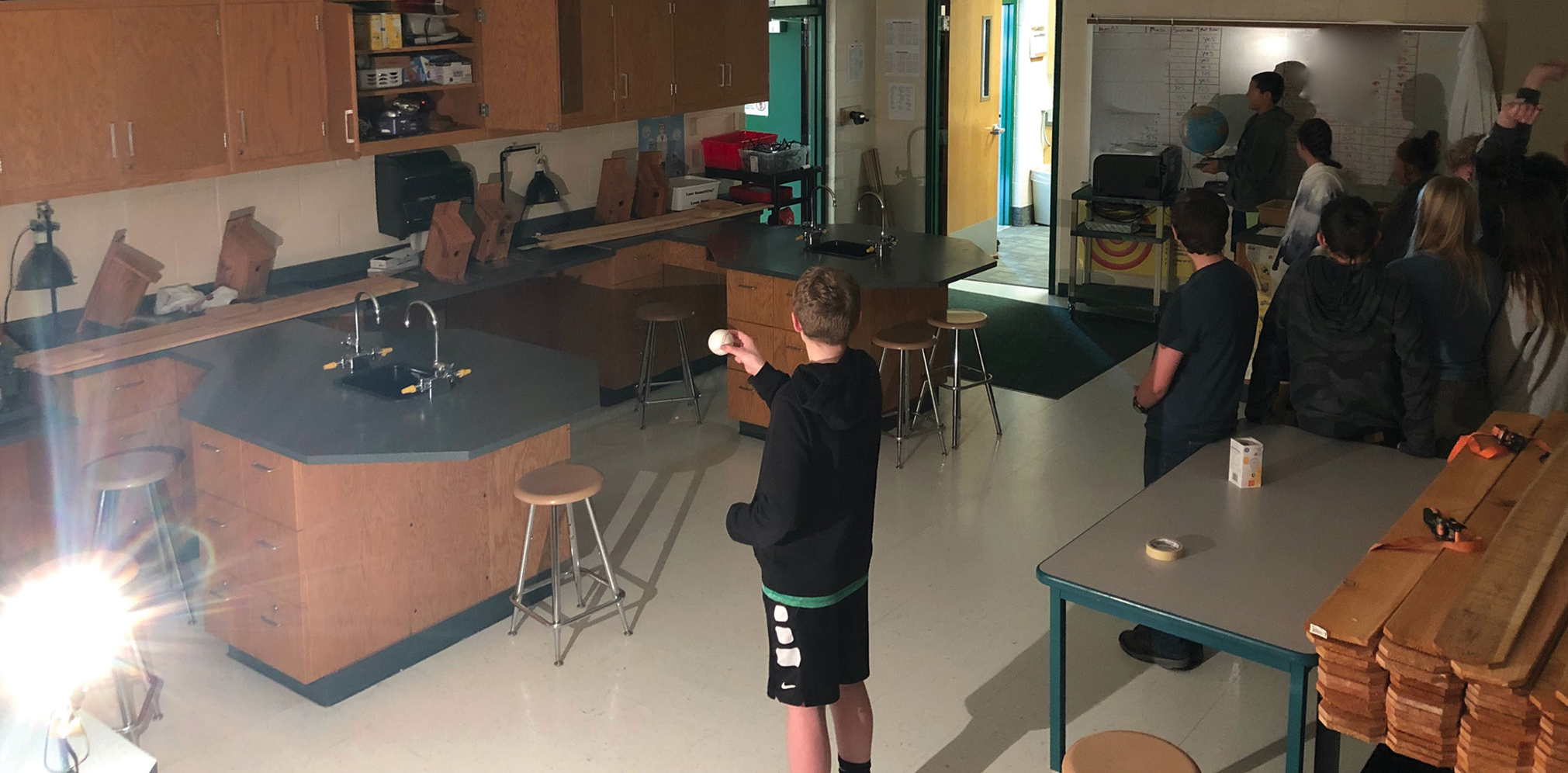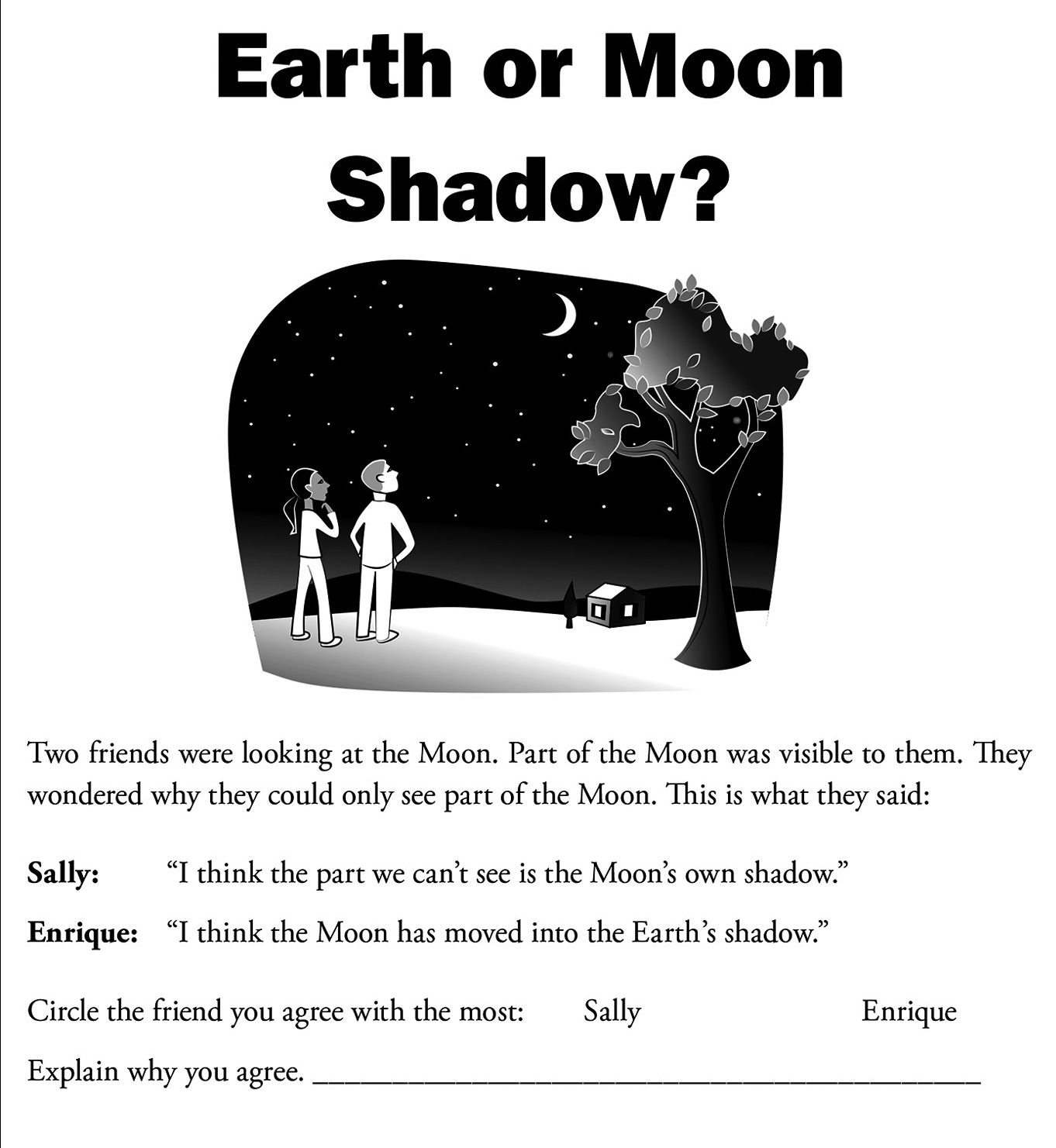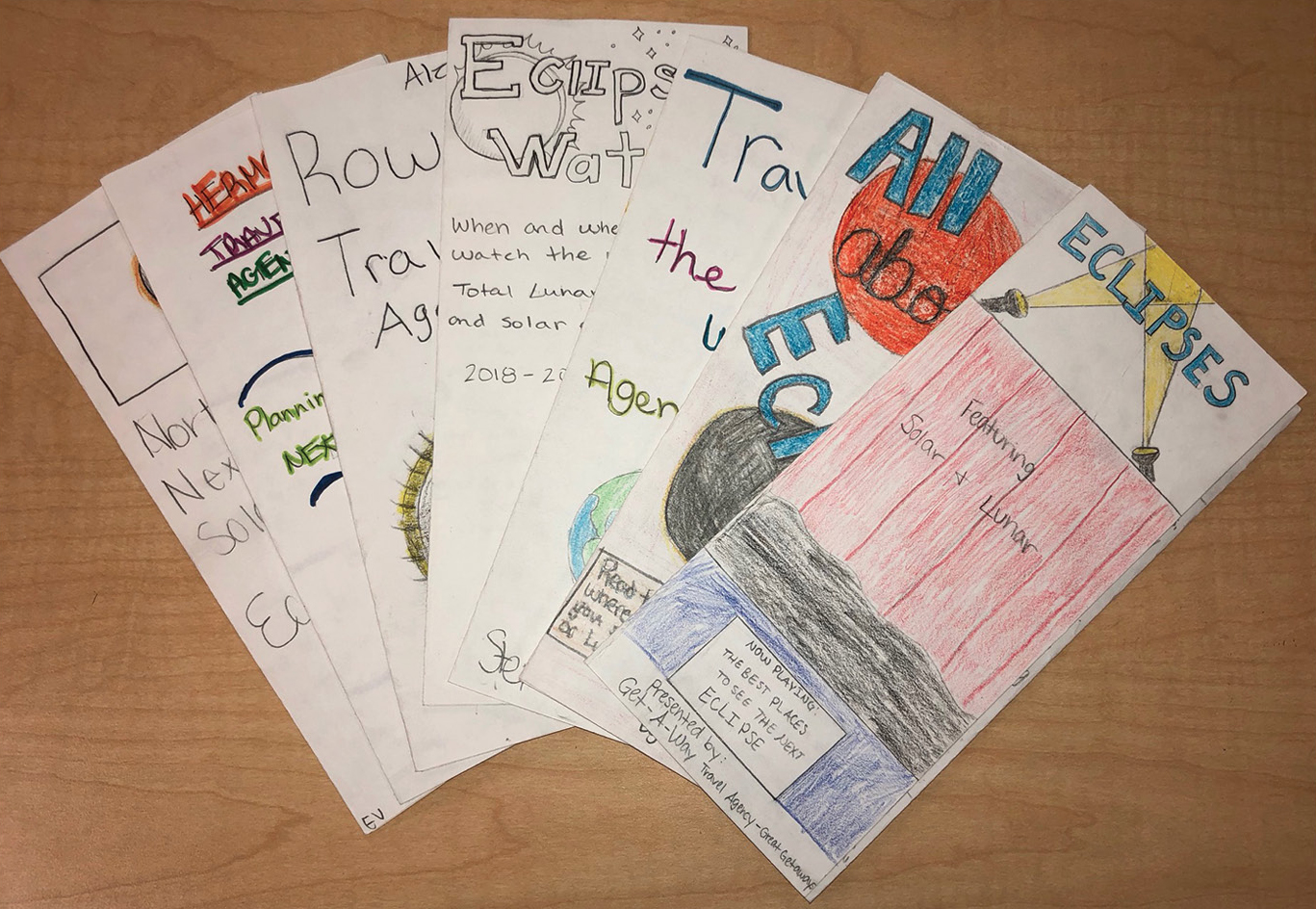feature
An Unforgettable Journey
Science Scope—March/April 2021 (Volume 44, Issue 4)
By Ron Ruckman, Debbie French, and Ana K. Houseal

CONTENT AREA Earth and Space Science
GRADE LEVEL 6–8
BIG IDEA/UNIT Eclipses
ESSENTIAL PRE-EXISTING KNOWLEDGE Prior knowledge about rotation, revolution, eclipses, and the Earth-Sun-Moon system
TIME REQUIRED 3–4 class periods
COST No additional costs beyond normal classroom materials
SAFETY No special safety concerns
My middle school students are fascinated by astronomy and ask lots of great questions, but like many students, they struggle with understanding challenging concepts such as Moon phases, gravity, and why eclipses occur. The purpose of this article is to provide an example of how to take tried-and-true learning activities, match them to a three-dimensional model (Houseal 2015), and connect them to the Ambitious Science Teaching (AST) framework (Windschitl, Thompson, and Braaten 2018; see Online Resources) and Next Generation Science Storylines (see Online Resources). These two frameworks were used to integrate the Earth science concepts of eclipses and motions of the Sun, Earth, and Moon by using the 2017 Great American Solar Eclipse as an anchoring phenomenon. Merging these ideas created authentic learning opportunities and a collaborative learning environment for my students. I found it put them in control of their learning and gave them the opportunity to engage in scientific discourse, use models to better learn a concept, and demonstrate their learning.
Two frameworks
The vision of the Next Generation Science Standards (NGSS Lead States, 2013) and the NextGenStorylines project is to create opportunities for students to make sense of phenomena in the way that scientists do (National Research Council [NRC] 2012). NextGenStorylines focus on the use of interesting, thought-provoking phenomena to get students to engage in authentic investigations (Reiser 2017). The term natural phenomena is defined as “observable events that occur in the universe that [students can use their] scientific knowledge to explain or predict . . . and figure out” (Achieve 2016, p. 1). A storyline is built by starting from students’ initial models and unresolved questions about a phenomenon. The teacher uses student questions to develop the activities and investigations to answer those questions and come up with new questions (Turley, Trotochaud, and Campbell 2016). These new questions will lead to new investigations. It is important for teachers to anticipate student questions so they can have investigations and data ready ahead of time (Reiser 2017). The anchoring phenomenon for this unit was solar and lunar eclipses. Although I had taught this topic before, it was my pedagogical practice that changed as I aligned activities I had previously used with this new storyline.
To make the NextGenStorylines method work, teachers must create a classroom environment in which students can engage in scientific inquiry, defined in the National Science Education Standards (NRC 1996) as “the diverse ways in which scientists study the natural world and propose explanations based on the evidence derived from their work” (p. 23). This idea, further developed and described by AST, has a goal of ensuring that every student is actively engaged with the subject matter and can apply what they have learned. There are four core practices of AST: planning for engagement with important science ideas, eliciting students’ ideas, supporting ongoing changes in students’ thinking, and drawing together evidence-based explanations (Windschitl, Thompson, and Braaten 2018, p. 4). The AST practices helped me to assist my students in participating in authentic science. By mapping my activities and instructional decisions to the AST framework, it allowed me to take a step back and put my students in charge of their learning. It allowed me to focus on student engagement with authentic data. It also allowed me to better anticipate students’ questions.
A snapshot from my classroom
As framing for this unit, it is important for the reader to know that our community was in the path of totality for the Great American Solar Eclipse on August 21, 2017. Also, on January 31, 2018, we were able to observe the Super Blue Blood Moon lunar eclipse. Because of timing and location, both were relevant and fresh in my students’ minds, making this an ideal anchoring phenomenon from which to develop this unit. The anchoring phenomenon was critical to the success of this unit as it helped to highlight other phenomena students noticed throughout the entire unit and was a way to coherently connect all of the science concepts I needed to teach. My students looked at images of both the solar and lunar eclipses and discussed why they thought eclipses occurred.
When I started the unit, my students shared their ideas about these phenomena. Using personal experiences and prior knowledge, students began to seriously think about and share ideas about possible causes for each eclipse. I listened carefully for partial understandings and alternate conceptions by noting the language students used and the way they made connections to their everyday experiences. Through discussion and guiding questions, the class identified a list of questions they needed to answer to understand the cause of eclipses, including:
- What kinds of eclipses are there?
- What are the sizes of the objects involved?
- Which objects are involved?
- What are the positions of the objects during an eclipse?
- How do the objects move (the mechanism of their movement)?
- When and where do eclipses happen?
- How do orbits affect an eclipse?
- What are the paths the objects follow?
From west to east
To determine the cause of solar eclipses, my eighth-grade students used various models to test some of their ideas. First, they used an eclipse simulator in Celestia, a web-based planetarium software, on the interactive whiteboard to better visualize the Earth-Moon-Sun system and see how the Moon revolves around the Earth (see Online Resources). To do this, I set up Celestia in advance to ensure students have the proper perspective (see Figure 1).

A screenshot of the Celestia 3D space simulation depicting the Earth-Moon-Sun system the day before the 8/21/2017 Great American Solar Eclipse.
Next, students used a globe to represent the Earth, a lamp to represent the Sun, and a baseball to represent the Moon to kinesthetically model different scenarios in three-dimensional space. Using these materials, students physically moved these items around to get their physical model of the Earth-Moon-Sun system to match what they were seeing in Celestia. It is important to note that by this time in the unit, students had also done extensive work with an eclipse simulator and had gained a fairly solid understanding of how the Moon moves around the Earth. We had discussed how, given the tilted path of the Moon, it is rare for the Sun, Moon, and Earth to align such that an eclipse can occur and that it could only occur at certain times of the year. At this point, they had reached consensus that solar eclipses were caused by the Moon moving directly between the Sun and the Earth. However, students were starting to make some other observations and had some new questions (see Figure 2).

Students modeling eclipses in their classroom.
As students were viewing a NASA video on eclipses (see link in Online Resources), one student noticed something perplexing. He realized the eclipse shadow from the Great American Eclipse, which we had looked at earlier in class, had moved across the Earth from west to east. He stated that we had already figured out that the Earth turns toward the east and that this meant the shadow should appear to travel from east to west, just like other objects we see in the sky.
Realizing that this question about the motion of the eclipse’s shadow was a great opportunity for scientific thinking, I challenged the students to figure it out. They were stumped until I restated the question in a way that could be tested. The students really needed to find out whether the shadow moved because of the Earth’s rotation or if it was because of something else. We talked about what the “something else” could be. They decided that because the Sun and the Moon were the only other objects involved, it had to be one of those. Everyone agreed the Sun probably was not the cause because Earth moved around it.
After more discussion, the student holding the baseball started moving it around the Earth and told the person with the globe to start spinning it. Several students jumped in and corrected the direction of the Moon. They remembered from previous class explorations and observations in Celestia that the Moon traveled in a counterclockwise direction when viewed from above the North Pole. Although none were ready to commit to an answer, the students had become very engaged in finding a solution. They were not worried about throwing out ideas because they knew that they would be seriously considered by the others in the room.
Students finally became convinced when someone suggested we use our bright lamp to represent the Sun and try the same sequence with the lights off. We positioned the Moon at the scale distance from the Earth (about 24 feet) so the shadow would be the right size. We started by holding the Moon still and had someone turn the Earth very slowly. As the Earth turned, we watched the North American continent move under the shadow. In this scenario, we noted that the shadow started on the East Coast and the continent moved under it until the shadow was on the West Coast. This was not the way the actual eclipse had moved! Now, the students were convinced it could not be the movement of the Earth, but they still wanted to see if the Moon’s movement would explain it. Next, they took the baseball and orbited it in the correct direction between the “Sun” and the “Earth.” The shadow moved from the west coast to the east coast just like it did in reality. It was because of the Moon’s movement! This extensive discussion and modeling helped the students understand why the shadow moved from west to east.
How did we get to this point?
For this unit, I prioritized discourse and publicly represented student ideas. Having students talk about their ideas and conceptual understanding proved to be a critical strategy. To facilitate discussion, I used talk moves such as revoicing, where I would restate what the student said to allow them to confirm my description as well as elaborate on their statement, explain their reasoning, or provide additional evidence to support their statement, and wait time, by giving students several minutes to deeply think about an issue, record their thoughts, and revisit the topic the next day or whenever it came up in future class sessions (Michaels, Shouse, and Schweingruber 2008). I also used questioning prompts outlined in “Teaching Practice Set: Eliciting Students’ Ideas and Adapting Instruction” (AST 2014) such as: What do you see going on here? How do you think this happens? Why do you think it happens this way?
For each lesson-level phenomenon, my students and I went through cycles that built on the four AST teaching practices mentioned earlier. However, it took many of these cycles to make up the entire storyline, which addressed the overall anchoring phenomenon.
An important consideration I took into account as I implemented this strategy was the importance of creating an environment where students felt safe to share their claims without personal judgement. Middle school students are notoriously worried about their image in the eyes of fellow classmates. Thus, one step we took was to create norms about how we could appropriately listen and respond to each other’s ideas, especially when there was disagreement. Students were required to be patient listeners and to be respectful of others’ ideas. Students also felt empowered to share their ideas and engage in scientific argumentation. The specifics of the norms we had agreed on were posted in the classroom as a reminder. We initially spent time discussing and sharing ideas in small groups. By allowing students to pose their ideas in a small-group setting and listen to others, they were able to sort and try out their own thoughts, becoming more confident when sharing to the larger group later.
Once students began to realize that this classroom was a safe place in which they could share ideas, and that they were able to reinforce our shared norms, they became more willing to throw out new ideas even when they might be wrong. As a result, students became more flexible in their thinking. Even incorrect ideas spurred new discussions and more creative thoughts. As students shared ideas, I recorded their ideas on the whiteboard where they remained visible throughout the unit. I also posted these ideas on our course management system. Their ideas drove further instruction as they were revisited throughout the unit. This validated students’ ideas, helping them realize that their thinking was important. It also helped to get the ideas out into the open where they could be critiqued by the classroom community. In this way, the ideas became community knowledge, which could be leveraged by anyone throughout the unit.
Assessment
Because students had become accustomed to sharing their ideas and commenting on others, I was able to get a good read on each student’s understanding of the concepts. This allowed me to make adjustments and help those who were still struggling with the big ideas.
To better identify students who may be struggling, I had students work in small groups to complete a formative assessment task based on Paige Keeley’s prompt, “#19 Earth or Moon Shadow?” (Keeley and Sneider 2012; see Figure 3). They had to determine which person in the scenario had a correct explanation of why the moon was crescent shaped. Student groups created a storyboard that used a model to explain with whom they agreed and why. Every group determined an answer and worked to develop their storyboard explanations. However, one group was having a heated argument about the mechanics of lunar phases. A student was confused about the positions of the Earth, Moon, and Sun. By the time I arrived, the other students were trying to explain it, but they were getting confused as well. The paraprofessional educator who had come over to help them admitted that she was confused, too. Previously, I would have given them a detailed explanation of the concept. However, what I did instead made all the difference. I said, “Let’s go to the lab and figure it out.” Students went to a nearby room, which could be darkened and had ample space for students to move about safely; however, this activity could be done in the regular classroom with the teacher providing students with necessary supplies. The students used a lamp, Styrofoam balls, and a simulation depicting Moon-Earth-Sun positions during different phases of the moon on their computers as a reference. They worked together to figure out how to make the Moon appear to have a crescent shape from Earth’s perspective using the lamp and Styrofoam balls. Within five minutes, students were excited to explain it to me. I suggested they try several other phase shapes to make sure they truly understood it. After a few more minutes with the model, they were pretty sure they had it.

Prompt for formative assessment task.
As a final check, I listened while students explained to the paraprofessional why the Moon goes through phases. At this point, it was clear that they understood it well; however, the paraprofessional still did not. To remedy this, I had the students take her to the lab to try it herself. They helped her use the model, which she had not done previously. Suddenly, we saw the realization hit her! In this case, both she and the students needed to use the kinesthetic models before they had the “aha!” moment.
I was able to use Keeley’s formative assessment probe the way these assessments are meant to be used—as a way to determine gaps and to help students change their thinking before moving on. Had I waited to assess until the end of the unit, it would have been too late to check my students’ understanding and clear up misconceptions that existed.
As a final assessment, I had students make a brochure about eclipses aimed at tourists who might want to visit a location where a future eclipse would occur. They were asked to explain how eclipses work and what visitors should know about the timing and location for the next solar eclipse and the next lunar eclipse. This gave me a snapshot of the depth of their understanding at the end of the unit. Students took a day in class to create their brochures on paper and included explanations and annotated eclipse diagrams.
Their brochures were assessed based on the rubric provided (see Figure 4; also see “planning for the next big eclipse rubric” in Supplemental Materials). The rubric was aligned with the Student Performance Expectations (PE) to capture evidence of students’ three-dimensional learning. To begin, I started by setting Level 3, which represented students meeting that standard for the part of the PE that this addressed. To set the levels above and below, I looked at the Science and Engineering Practices, Disciplinary Core Ideas, and Crosscutting Concepts progression in Appendix E, F, and G of the Next Generation Science Standards. From there, I thought about what understanding a student would have to demonstrate to go from Level 3 to Level 4. I looked at the high school progression to determine what a Level 4 should look like. Similarly, I looked at earlier grades to develop Levels 1 and 2 of the rubric, which indicated that their ideas were not fully matching the middle level PE.

Students showcased their knowledge by creating travel brochures for visitors traveling to a region where an eclipse would occur.
Final thoughts
There were several instances during this unit when either a student or I noticed something interesting or perplexing. The earlier vignette showcased one of many completely spontaneous questions and subsequent investigations. Students were more engaged during these impromptu investigations because they were invested in the outcome. These opportunities helped students build a deep conceptual understanding of science ideas that previously might have been just “covered” in class. However, it wasn’t magic; it was due to deliberate planning and the implementation of the AST and NextGenStorylines frameworks.
The Great American Solar Eclipse and the Super Blue Blood Moon Lunar Eclipse fascinated my students. These two celestial events led us on an unforgettable journey of teaching and learning about these Earth science concepts ambitiously and through the use of storylines. During this process, my students wrestled with complex ideas and spatial patterns to uncover the causes of eclipses for themselves. This fostered rich learning that otherwise would not likely have occurred through using two-dimensional diagrams from textbooks.
Although it was initially uncomfortable to be asked a question I didn’t have an answer for, I was modeling what I wanted my students to become—critical, independent thinkers who were not afraid to grab a globe and a flashlight off the shelf to uncover the answer for themselves, instead of opening their favorite internet browser to search for the answer. •
Online Resources
Ambitious Science Teaching website—https://ambitiousscienceteaching.org/
Celestia planetarium software—https://celestia.space/download.html
NASA video of the eclipse—https://www.youtube.com/watch?v=wpCyFSugwdM
Next Generation Science Storylines—http://www.nextgenstorylines.org/
Video clips and simulations (p. 33); student activities, storylines, and assessments (Appendices)—https://mountainscholar.org/handle/20.500.11919/3136
Supplemental Materials
Connecting to the Next Generation Science Standards
Planning for the next big eclipse rubric
Ron Ruckman is a science teacher at Pinedale Middle School in Pinedale, Wyoming; Debbie French (frenchd@wfu.edu) is an assistant professor of science education in the Department of Education at Wake Forest University in Winston-Salem, North Carolina; and Ana K. Houseal is an associate professor and outreach science educator in the Science and Mathematics Teaching Center at the University of Wyoming in Laramie, Wyoming.


